Introduction
To be honest — diving into the world of solar panels can feel extremely overwhelming. You might see all sorts of numbers, like “$10,000 system costs” or “8-year payback periods,” but what do those actually mean for you?
If you’re like most homeowners just starting to explore solar in 2025, one of the smartest ways to compare options is by understanding the solar panel cost per watt. This simple yet powerful metric cuts through the noise and helps you figure out whether you’re getting a fair deal — or getting overcharged.
In this guide we will help you find solar panel cost per watt 2025 and break down what “cost per watt” means, what you should expect to pay in 2025 and how to get the most value for your investment without all the confusing stuff.
What Does “Cost Per Watt” Mean in Solar Power?
Let’s keep it simple.
In simple terms cost per watt refers to the total price of a solar panel system divided by its total power capacity. Have a look at below example for more clarity.
- Total power capacity = 6kW (6000-watt)
- Cost of the complete system = $15,000
- Then cost per watt = 15000 ÷ 6000 = 2.50
In this example your cost per watt comes to be $2.50 This number helps you compare the value across different systems and installers, no matter the size of the system.
Average Solar Panel Cost per Watt in the U.S. (2025)
According to recent reports and installer quotes:
The average solar panel cost per watt in the U.S. in 2025 is between $2.50 and $3.50, before tax credits.
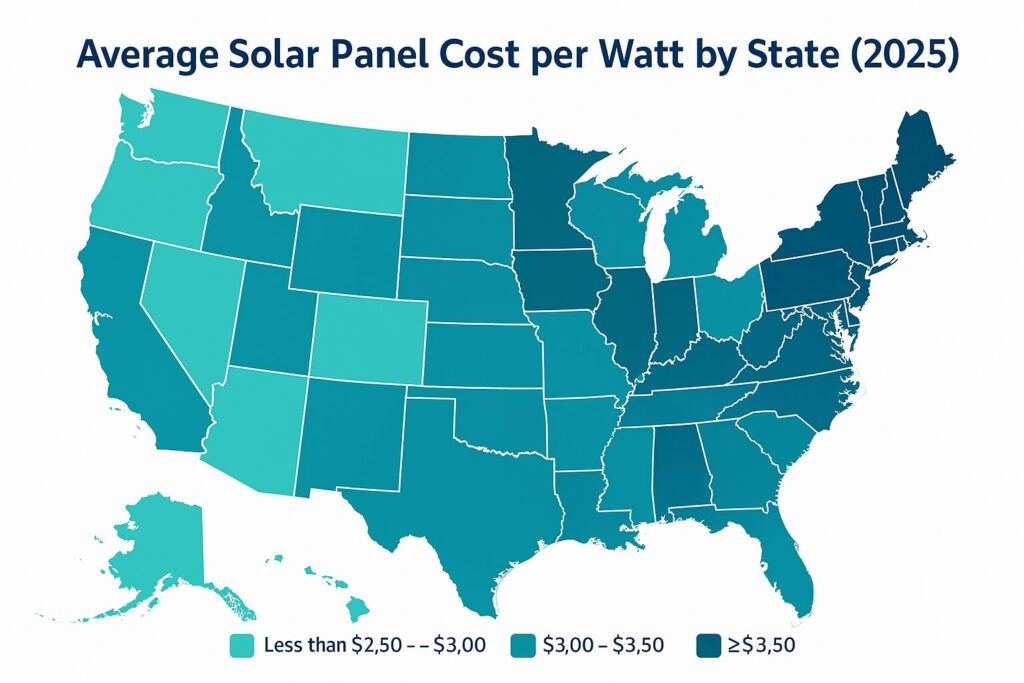
Here’s a quick breakdown by state:
| State | Avg Cost per Watt (Before Incentives) |
| California | $2.65 |
| Texas | $2.45 |
| Florida | $2.70 |
| New York | $3.10 |
| Arizona | $2.60 |
Note: These are rough averages. Actual prices may vary depending on installer, panel brand, and system size.
Factors That Affect Solar Panel Cost per Watt in 2025
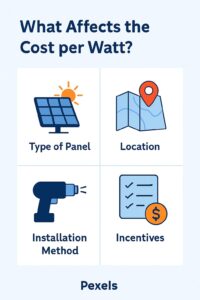
Multiple factors come into play to determine how much you would pay per watt:
- Type of Solar Panel: Monocrystalline (more efficient, more expensive) vs Polycrystalline
- System Size: Bigger systems often cost less per watt
- Installation Type: Ground-mounted vs rooftop
- Labor and Permitting: Varies by state/city
- Rebates & Incentives: Federal tax credit (ITC), state/local programs
Brand and Warranty: Premium brands charge more per watt
How to Lower Your Solar Panel Cost per Watt
Looking to save? Here are some tips:
- Compare at least 3-4 quotes from different solar installers
- Take advantage of the 30% Federal Solar Tax Credit (ITC)
- Check for state incentives or utility rebates
- Consider group buying programs or solar co-ops
Opt for mid-range panels with solid warranties instead of premium brands
Premium vs Budget: Is Higher Solar Panel Cost per Watt Worth It?
Not always—but sometimes yes.
Higher quality panels may:
- Last longer (25–30 years)
- Have lower degradation over time
- Come with better warranties
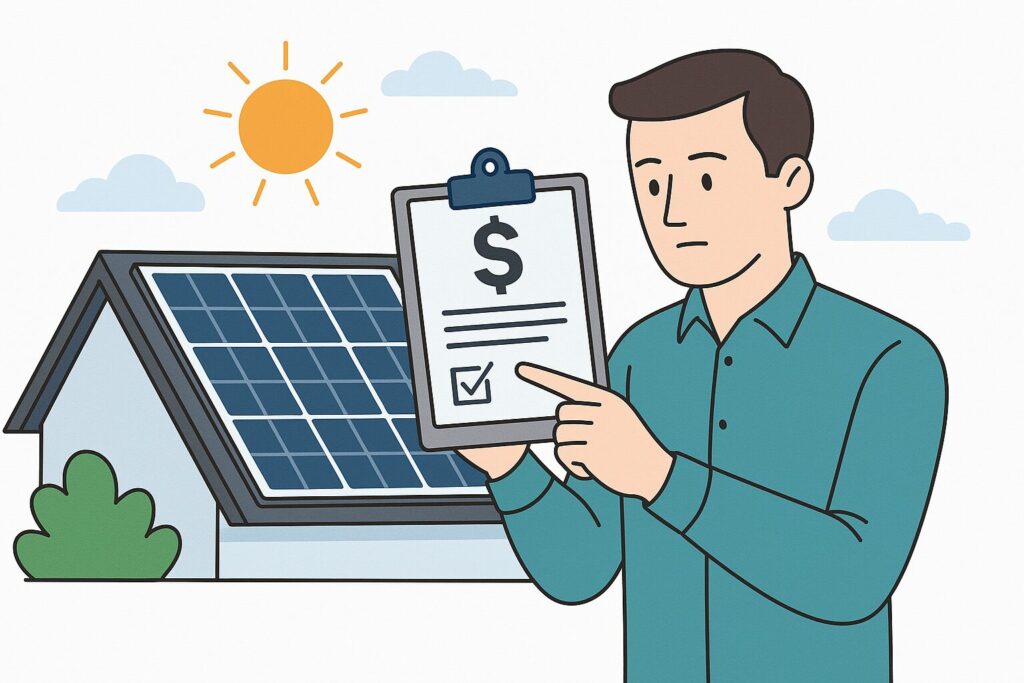
But if your goal is pure ROI (return on investment), a lower-cost system with a good installer might win out. Think of it like buying a car: not everyone needs a Tesla. Sometimes a reliable Honda does the job perfectly.
Real-World Example: 6kW System Breakdown
Here’s a quick breakdown for you:
- Total system size: 6,000 watts
- Installer quote: $16,200
- Federal tax credit (30%): -$4,860
- Net cost: $11,340
- Effective cost per watt: $11,340 ÷ 6,000 = $1.89 per watt
Not bad, right?
Solar Pricing 2025: Are Solar Panel Costs per Watt Going Down?
Short answer: Yes, but not as drastically as compared to previous years.
From 2010 to 2022, solar panel costs have reduced fairly. Thanks to manufacturing scale and tech improvements. But since a couple of years, prices are a bit more stable. Supply chain issues from recent years have mostly smoothed out, and manufacturing costs are relatively flat. However, there’s still gradual price compression, especially as more U.S.-based manufacturing ramps up.
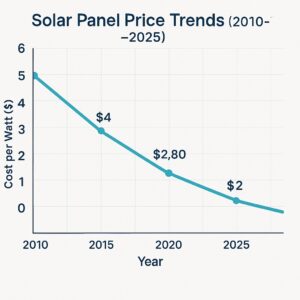
In short you are still getting good value — but don’t expect any drastic drop overnight. If you’re waiting for a big price crash, you might be waiting forever.
Pro tip: Instead of timing the market, focus on locking in long-term savings now while the 30% Federal Tax Credit is still active.
How Financing Affects Cost Per Watt
If you’re paying for your solar system upfront, your cost per watt is clear-cut. But if you’re using financing — like a solar loan or lease — things get a little murky.
Here’s what happens:
- With a loan, you’ll pay interest over time, which increases your total cost and, therefore, your effective cost per watt.
- With a lease or PPA, you don’t own the system, but you might see immediate monthly savings. However, your cost per watt isn’t
directly transparent in these setups.
That’s why we recommend:
- Asking for the “all-in effective cost per watt” from any solar financing offer.
- Comparing it with an outright purchase to see what gives you better value over 20–25 years.
Remember: Just because the monthly payment looks low doesn’t mean the total cost is.

FAQ: Quick Answers to Common Questions
Q: What’s a good cost per watt for solar panels in 2025?
A: Anything around $2.50–$3.00 before tax credit is considered good.
Q: How do I know if I’m overpaying?
A: Get multiple quotes and compare the solar panel cost per watt—not just the total price.
Q: Does DIY solar lower the cost per watt?
A: It can—but only if you know what you’re doing. Mistakes can cost more in the long run.
For easy solar related calculations – Try out our SOLAR SAVINGS CALCULATOR !!
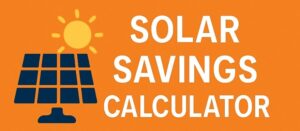
Conclusion: Why Cost per Watt Matters More Than Ever
In 2025, solar energy is more accessible than ever—but the key to making a smart investment lies in understanding your cost per watt. It’s the clearest, most apples-to-apples way to compare solar options.
So next time you see a solar quote, don’t just ask, “How much is the system?” Ask:
“How much am I paying per watt—and is it worth it?”
And if you’re using financing, make sure you’re not paying extra without realizing it. A good solar deal isn’t just about the system — it’s about long-term value.
To learn more on such topics check out similar articles here – Solar Power Basics
You can also request topic which you need clarity on and we will try our best to provide you with the most up to date information.
Also checkout these interesting reads:

